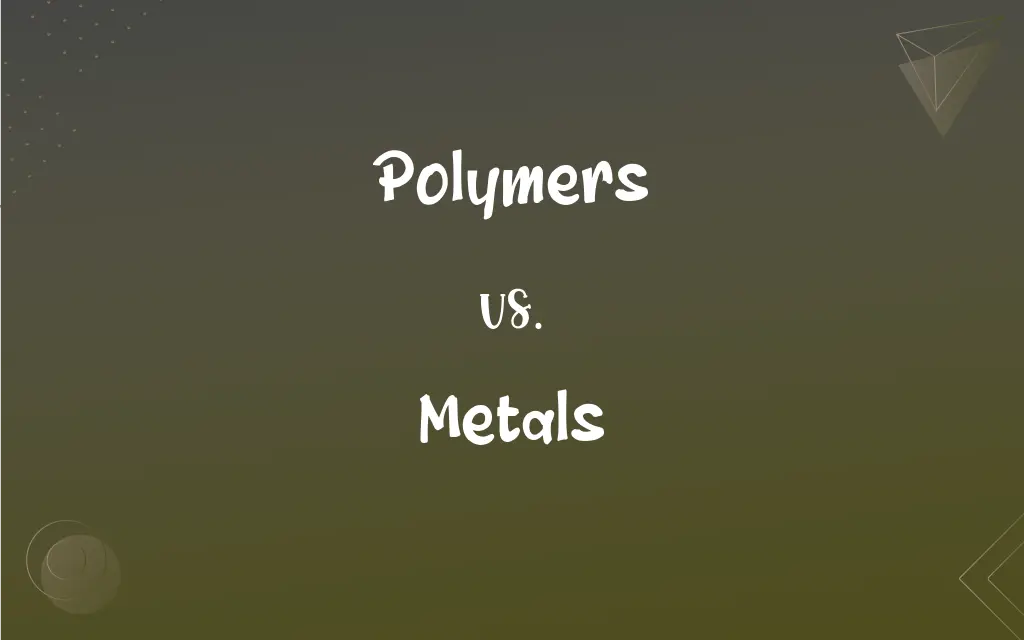Polymers vs. Metals: What's the Difference?
Edited by Aimie Carlson || By Janet White || Published on February 28, 2024
Polymers are large molecules made of repeating units, often organic, with versatile uses; metals are elements with high conductivity and malleability, used in construction and technology.

Key Differences
Polymers are composed of long chains of repeating units, typically carbon-based, and exhibit flexibility. Metals are elemental substances characterized by their ability to conduct electricity and heat, and their shiny appearance.
Polymers can be natural, like DNA, or synthetic, like plastic, and are used in a vast array of products due to their versatility. Metals, such as iron or copper, are used in construction and manufacturing due to their strength and durability.
Polymers generally have lower melting points and are less dense compared to metals. Metals have high melting points and densities, making them ideal for heavy-duty structural applications.
Polymers are often insulators of electricity and heat, making them suitable for applications like electrical insulation. Metals, being good conductors, are used in electrical wiring and electronic components.
Polymers can be engineered for specific properties like flexibility, strength, or chemical resistance. Metals can be alloyed to enhance characteristics like strength, corrosion resistance, or thermal conductivity.
ADVERTISEMENT
Comparison Chart
Composition
Long chains of repeating units, often organic.
Elemental substances with conductive properties.
Typical Use
Diverse products, from packaging to textiles.
Structural, in construction and technology.
Physical Properties
Flexible, lower melting points, lower density.
Malleable, high melting points, high density.
Electrical Properties
Generally insulators.
Conductors of electricity and heat.
Engineering
Customizable for specific properties.
Alloyed for enhanced characteristics.
ADVERTISEMENT
Polymers and Metals Definitions
Polymers
Polymers can be naturally occurring or synthetic materials.
DNA is a natural polymer essential to biological functions.
Metals
Metals are elements known for their conductivity, malleability, and luster.
Copper is used extensively in electrical wiring due to its high conductivity.
Polymers
Polymers are integral in various industries, including textiles and packaging.
Nylon, a synthetic polymer, is widely used in the textile industry.
Metals
Metals can be alloyed to enhance properties like strength and corrosion resistance.
Stainless steel, an alloy of iron, is prized for its corrosion resistance.
Polymers
Polymers are large molecules made of repeated subunits, known as monomers.
Polyethylene, a common polymer, is widely used in plastic bags.
Metals
Metals are used in a variety of applications, from construction to electronics.
Aluminum is used in aircraft manufacturing due to its lightweight and strength.
Polymers
Polymers exhibit diverse properties, including flexibility and durability.
Silicone, a synthetic polymer, is used for its flexible and heat-resistant properties.
Metals
Metals are typically solid at room temperature, with high melting points.
Gold, known for its malleability and ductility, is used in jewelry and electronics.
Polymers
Polymers are often used for their insulating properties in electrical applications.
Polyvinyl chloride (PVC) is used in electrical cable insulation.
Metals
Metals are characterized by their ability to form positive ions and metallic bonds.
Iron is used in construction for its strength and metallic bonding.
Polymers
Any of numerous natural and synthetic compounds of usually high molecular weight consisting of up to millions of repeated linked units, each a relatively light and simple molecule.
Metals
Any of a category of electropositive elements that usually have a shiny surface, are generally good conductors of heat and electricity, and can be melted or fused, hammered into thin sheets, or drawn into wires. Typical metals form salts with nonmetals, basic oxides with oxygen, and alloys with one another.
Polymers
Plural of polymer
FAQs
What are the physical properties of metals?
Metals have high melting points, are malleable, ductile, and have a shiny appearance.
Can polymers conduct electricity?
Most polymers are electrical insulators, though some conductive polymers exist.
What makes metals good conductors?
Metals are good conductors due to the free movement of electrons in their structure.
How are polymers used in everyday life?
Polymers are used in packaging, textiles, household goods, and electronics.
What are polymers made of?
Polymers are made of long chains of repeating units called monomers.
Are polymers environmentally friendly?
It depends; some polymers, like bioplastics, are eco-friendly, while others can be pollutants.
Can polymers be recycled?
Many polymers, like certain plastics, can be recycled, though the process varies.
What are biopolymers?
Biopolymers are polymers produced from natural sources, like cellulose and proteins.
Can polymers be used in medical applications?
Yes, polymers like silicone and nylon are used in various medical devices and implants.
What are alloys and why are they important in metals?
Alloys are mixtures of metals that enhance properties like strength and corrosion resistance.
What role do metals play in technology?
Metals are crucial in technology, particularly in electronics and machinery.
What is the role of iron in construction?
Iron is used in construction for its strength, especially in steel form.
How are synthetic polymers made?
Synthetic polymers are made through chemical processes like polymerization.
How do polymers affect the environment?
Synthetic polymers can be pollutants, but biodegradable polymers offer environmental benefits.
What are examples of metal alloys?
Examples include steel, brass, and bronze.
What are the main uses of copper?
Copper is primarily used in electrical wiring and plumbing.
What is the difference in melting points between polymers and metals?
Metals generally have much higher melting points than polymers.
Are metals renewable resources?
Metals are not renewable but can be recycled and reused.
Why is aluminum used in aircraft?
Aluminum is used for its lightweight and strength, ideal for aircraft structures.
What is the significance of gold in electronics?
Gold is used in electronics for its excellent conductivity and resistance to corrosion.
About Author
Written by
Janet WhiteJanet White has been an esteemed writer and blogger for Difference Wiki. Holding a Master's degree in Science and Medical Journalism from the prestigious Boston University, she has consistently demonstrated her expertise and passion for her field. When she's not immersed in her work, Janet relishes her time exercising, delving into a good book, and cherishing moments with friends and family.
Edited by
Aimie CarlsonAimie Carlson, holding a master's degree in English literature, is a fervent English language enthusiast. She lends her writing talents to Difference Wiki, a prominent website that specializes in comparisons, offering readers insightful analyses that both captivate and inform.































































